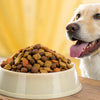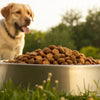Can You Keep Dry Dog Food in the Refrigerator?
- Houndsy
Table of Contents
- Introduction
- Understanding Dry Dog Food Storage
- Can You Refrigerate Dry Dog Food?
- Best Practices for Storing Dry Dog Food
- The Role of Houndsy in Enhancing Dog Feeding
- Reflecting on Your Pet Feeding Routine
- Conclusion
Introduction
As devoted pet owners, we often find ourselves pondering the best ways to care for our furry companions, especially when it comes to their diet. Did you know that improper storage of dog food can lead to nutritional degradation and spoilage? In fact, a staggering 60% of pet owners are unaware of the optimal conditions for storing dry dog food, which can significantly impact their pet's health.
The topic of dog food storage is not just practical; it’s essential for ensuring our pets receive the best nutrition possible. One question that frequently arises is: Can you keep dry dog food in the refrigerator? This blog post aims to address this question thoroughly, exploring the implications, pros and cons, and best practices for storing dry dog food.
By the end of this post, you'll gain valuable insights into effective dog food storage methods, understand how to maintain the freshness and nutritional value of your dog's kibble, and learn why these practices matter. We'll also reflect on how our daily routines can impact our pets' health, inviting you to consider your own feeding practices. So, let's dive into this essential aspect of pet care!
Understanding Dry Dog Food Storage
Why Proper Storage Matters
Proper storage of dry dog food is paramount for several reasons:
- Nutritional Integrity: The quality of your dog's food can degrade over time if not stored correctly. Key vitamins and minerals can lose their potency, affecting your pet's overall health.
- Freshness: Stale dog food can lead to poor palatability and digestive issues for your dog. Nobody wants to feed their pup something that smells or tastes off.
- Safety: Mold, pests, and bacteria can compromise the safety of dog food. Proper storage minimizes these risks.
Common Misconceptions About Dog Food Storage
Many pet owners hold misconceptions regarding the best practices for storing dry dog food. Some believe that refrigeration is a surefire way to keep food fresh, while others may think that simply leaving it in the bag is sufficient. Let's clarify these beliefs:
- Refrigeration is Always Best: While keeping some types of food in the fridge can enhance freshness, dry dog food is typically best stored in a cool, dry place at room temperature. Refrigeration can introduce moisture, which is detrimental to kibble.
- Plastic Bags are Adequate: Many pet owners store their dog food in the original bag. However, this can expose the food to air and moisture. An airtight container is often a better choice.
The Ideal Storage Environment
The ideal conditions for storing dry dog food include:
- Cool Temperature: Keep the food in a place that remains below 80°F (27°C). Higher temperatures can accelerate spoilage.
- Low Humidity: Moisture is a major enemy of dry dog food. Ensure the storage area is dry to prevent mold growth.
- Darkness: Light can degrade the food as well, so a dark storage area is preferable.
Can You Refrigerate Dry Dog Food?
The Case Against Refrigeration
While it might seem logical to keep dry dog food in the refrigerator, there are several reasons against this practice:
- Moisture Concerns: Refrigerators can introduce moisture, leading to clumping or spoilage of kibble. Moisture can also promote the growth of mold.
- Temperature Fluctuations: Opening and closing the refrigerator door can create temperature variations, which can affect the food's quality.
- Odor Absorption: Dry dog food can absorb odors from other foods in the refrigerator, potentially making it less palatable for your pet.
Expert Opinions
Veterinarians and pet nutritionists generally advise against refrigerating dry dog food. For instance, the American Kennel Club recommends storing dry food in a cool, dry place and emphasizes the importance of using airtight containers to maintain freshness.
Best Practices for Storing Dry Dog Food
Choosing the Right Container
Investing in a good storage container can make all the difference. Here are some features to look for:
- Airtight Seal: A container with a tight-fitting lid prevents air from entering, keeping the food fresh.
- Material: Opt for BPA-free plastic, stainless steel, or glass. These materials are durable and easy to clean.
- Size: Choose a container that fits your needs. If you purchase large bags of kibble, ensure the container can accommodate the full amount.
Storing Kibble Safely
- Keep It Sealed: Always close the container tightly after each use to limit exposure to air.
- Avoid Direct Sunlight: Store the container in a dark cabinet or pantry to protect from light degradation.
- Label the Container: If you transfer kibble into a different container, label it with the type of food and the expiration date.
- Monitor for Freshness: Check your dog food periodically for signs of spoilage, such as an off smell, discoloration, or changes in texture.
The Role of Houndsy in Enhancing Dog Feeding
At Houndsy, we believe that elevating the feeding experience goes beyond just providing food; it’s about creating a beautiful and functional environment for our pets. Our flagship product, the Houndsy Kibble Dispenser, is designed to simplify and enhance the feeding ritual.
Key Features of the Houndsy Kibble Dispenser
- Beautiful Design: Our mid-century modern design not only complements your home decor but also provides an elegant solution to dog feeding.
- Ergonomic Convenience: The dispenser's standing height eliminates the need for bending, making feeding easier for pet parents.
- Perfect Portion Control: With our unique crank mechanism, you can dispense the ideal amount of kibble every time.
- Large Capacity: The dispenser holds 25–30 lbs of kibble, reducing the need for frequent refills.
- BPA-Free Liner: The liner ensures that kibble stays fresh and free from contaminants.
- Auto-Locking Mechanism: This feature prevents accidental dispensing, keeping curious pets—especially toddlers—safe.
Investing in a Houndsy Kibble Dispenser not only enhances convenience and functionality but also adds a touch of style to your pet care routine.
Reflecting on Your Pet Feeding Routine
As we explore the intricacies of dog food storage, it's essential to reflect on our own feeding practices. How do you currently store your dog's food? Are there areas for improvement in maintaining its freshness and quality?
By adopting better storage practices and investing in quality products like the Houndsy Kibble Dispenser, we can significantly enhance our pets' feeding experience.
Conclusion
In conclusion, while the idea of refrigerating dry dog food may seem appealing, it is generally not the best practice. Instead, focus on creating an optimal storage environment that maintains freshness, nutrients, and safety. Always opt for airtight containers, keep the food in a cool, dark place, and monitor for signs of spoilage.
As responsible pet owners, understanding the implications of our storage choices allows us to provide our furry friends with the best nutrition possible. We encourage you to explore our Houndsy Kibble Dispenser to elevate your dog feeding experience and ensure the health and happiness of your beloved pet.
FAQ
1. Can I freeze dry dog food?
Yes, you can freeze dry dog food, but it’s not necessary. If you choose to do so, ensure it’s stored in airtight containers to prevent freezer burn. The food should be used within three to six months after thawing.
2. How long does dry dog food last once opened?
Once opened, dry dog food should ideally be consumed within 30 days for optimal freshness and nutritional value.
3. What are the signs that dog food has gone bad?
Signs include a rancid or moldy smell, visual signs of mold, discoloration, or changes in texture.
4. Is it safe to store dog food in plastic containers?
Yes, it is safe to use plastic containers. Just ensure they are BPA-free and thoroughly cleaned between uses.
5. How can I keep my dog’s food fresh for longer?
Store the food in a cool, dry place in an airtight container, and avoid exposing it to light and moisture.
By following these guidelines, you can ensure your dog's food remains fresh and nutritious, contributing to their overall health and happiness.












